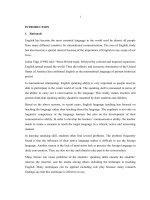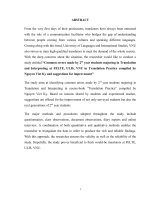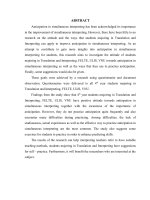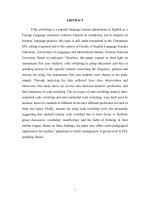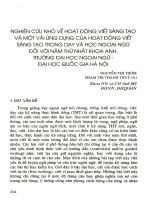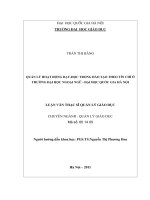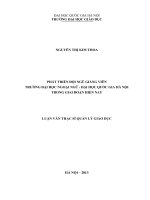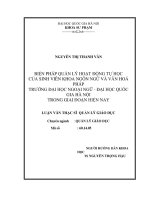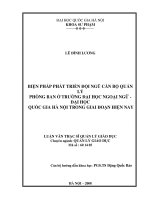DỰ đoán TRƯỚC TRONG PHIÊN DỊCH ĐỒNG THỜI CHO SINH VIÊN CHUYÊN NGÀNH BIÊN – PHIÊN DỊCH, đại học NGOẠI NGỮ, đại học QUỐC GIA hà nội
Bạn đang xem bản rút gọn của tài liệu. Xem và tải ngay bản đầy đủ của tài liệu tại đây (436.76 KB, 54 trang )
ABSTRACT
Anticipation in simultaneous interpreting has been acknowledged its importance
in the improvement of simultaneous interpreting. However, there have been little to no
research on the attitude and the ways that students majoring in Translation and
Interpreting can apply to improve anticipation in simultaneous interpreting. As an
attempt to contribute to gain more insights into anticipation in simultaneous
interpreting for students, this research aims to investigate the attitude of students
majoring in Translation and Interpreting, FELTE, ULIS, VNU towards anticipation in
simultaneous interpreting as well as the ways that they use to practice anticipation.
Finally, some suggestions would also be given.
These goals were achieved by a research using questionnaire and document
observation. Questionnaires were delivered to all 4th year students majoring in
Translation and Interpreting, FELTE, ULIS, VNU.
Findings from the study show that 4th year students majoring in Translation and
Interpreting, FELTE, ULIS, VNU have positive attitude towards anticipation in
simultaneous interpreting together with the awareness of the importance of
anticipation. However, they do not practice anticipation quite frequently and also
encounter many difficulties during practicing. Among difficulties, the lack of
studiousness, actual experiences as well as the effective way to practice anticipation in
simultaneous interpreting are the most common. The study also suggests some
exercises for students to practice in order to enhance predicting skills.
The results of the research can help interpreting teachers refer to have suitable
teaching methods, students majoring in Translation and Interpreting have suggestions
for self – practice. Furthermore, it will benefit the researchers who are interested at the
subject.
TABLE OF CONTENT
ABSTRACT..........................................................................................................i
CHAPTER 1: INTRODUCTION......................................................................1
1.3.Significance of the study............................................................................3
1.4. Scope of the study......................................................................................3
1.5. The organization of the study...................................................................3
CHAPTER 2: LITERATURE REVIEW..........................................................5
2.2.Overview of interpreting...........................................................................6
2.2.1.Interpreting............................................................................................................................6
2.2.2.Types of interpreting..............................................................................................................7
2.2.3.Simultaneous interpreting...................................................................................................10
2.3.Anticipation in simultaneous interpreting.............................................12
2.3.1.Definition of anticipation.....................................................................................................12
2.3.2.Anticipation in simultaneous interpreting............................................................................12
2.3.3.Anticipation as an important strategy in simultaneous interpreting....................................13
2.3.4.Types of anticipation in simultaneous interpreting..............................................................15
2.3.5.Anticipation improvement...................................................................................................16
CHAPTER 3: METHODOLOGY...................................................................18
3.1. Sampling method.....................................................................................18
3.2. Data collection method............................................................................19
3.2.1. Data collection instruments................................................................................................19
3.2.2. Data collection procedure...................................................................................................20
3.3. Data analysis method..............................................................................21
3.3.1. Data from questionnaire.....................................................................................................21
3.3.2. Data from document observation.......................................................................................22
CHAPTER 4: RESULTS AND DISCUSSION...............................................23
4.1. Findings....................................................................................................23
4.2. Implication...............................................................................................37
CHAPTER 5: CONCLUSION.........................................................................39
5.1. Summary of findings...............................................................................39
5.3.Suggestions for further research.............................................................41
REFERENCES..................................................................................................42
APPENDIX 1.....................................................................................................45
APPENDIX 2.....................................................................................................48
APPENDIX 3.....................................................................................................49
LIST OF TABLES, FIGURES
Figure 1
Figure 2
Figure 3
Interpreting in different spheres of social interaction
Conceptual spectrum of interpreting
The attitude of students towards anticipation in simultaneous
8
9
24
Figure 4
Figure 5
interpreting
The frequency of practicing anticipation in simultaneous interpreting
Reasons for having never practiced anticipation in simultaneous
26
27
Figure 6
Figure 7
Table 1
interpreting
Proportion of students practicing anticipation in class and at home
The overall level of difficulty
Summary of the order of difficulties in anticipation in simultaneous
29
33
31
interpreting
CHAPTER 1: INTRODUCTION
This first chapter will provide the rationale, the aims and objectives, the
organization and significance of the research. In addition, the research questions are
addressed to work as a guideline for the whole research.
1.1.
Statement of the problem and the rationale of the study
In the past, due to historical conditions of the country, the opportunities for
Vietnamese people to approach foreign culture and the world economy were limited as
well as restricted in some Asian and Eastern European countries. Therefore,
interpreters, especially English interpreters, received scant attention.
Nowadays, with the rapid socioeconomic development and the integration of
Vietnam into the world, the demand of cultural exchange and multifaceted cooperation
among Vietnam and other countries keeps rising. More and more international
conferences, forums, events or casual dialogues have been held in Vietnam. In this
context, language differences become a big obstacle hindering these activities and
furthermore, the development of the country. As a result, the need for interpreters,
especially simultaneous interpreters with the advantage of time saving and
convenience also increases. Moreover, at present, the number of students who major in
interpreting and want to improve their simultaneous interpreting has considerably
enhanced.
In addition, given the fact that simultaneous interpreting is a tough job which
requires many skills, right at the university, interpreter trainees should be equipped
with necessary competence in dealing with difficulties potentially occurring during
their performance. Anticipation is one of these skills.
The importance of anticipation has been acknowledged by many researchers
like Moser 1978, Le Ny 1978, Herbert 1952, Gile 1995, Chernov 1992, Lederer 1981,
etc. (as cited in Besien 1999). According to Chervov (2004, Eds.), “it was probability
anticipation of the development of the message made by interpreter that made
simultaneous interpretation possible at all under the extreme conditions of this task”
(p.169). In other words, anticipation can help interpreters be more favorable and active
while carrying on their work.
Although having generally acknowledged, in Vietnam, anticipation in
simultaneous interpreting has not attracted adequate notice. Specifically, in the
curriculum of Interpreting subject at University of Languages and International
Studies, Vietnam National University, Hanoi, there is no time for teaching
anticipation. Additionally, there is almost no research on training anticipation in
simultaneous interpreting for students majoring in Translation and Interpreting.
Therefore, as one attempt to examine this under-researched topic, the researcher
decided to conduct a study “Anticipation in simultaneous interpreting for students
majoring in Translation and Interpreting, FELTE, ULIS, VNU”.
1.2.
Aims and objectives of the study
First of all, the research aims at identifying the attitude of 4 th year students
majoring in Translation and Interpreting, FELTE, ULIS, VNU towards anticipation in
simultaneous interpreting. Afterwards, the ways that they have used to practice
anticipation in simultaneous interpreting would be addressed. Finally, through data
collected, the ways or techniques that the students, who major in Interpreting and
Translating, FELTE, ULIS can apply for practicing anticipation in simultaneous
interpreting would be suggested.
In order to gain the objectives, the research was conducted to answer the
following questions:
1. What is the attitude of 4 th year students majoring in Translation and
interpreting, FELTE – ULIS towards anticipation in simultaneous interpreting?
2. In what ways do 4th year students majoring in Translation and Interpreting,
FELTE - ULIS practice anticipation in simultaneous interpreting?
3. What are suggestions for students to practice anticipation in simultaneous
interpreting?
1.3. Significance of the study
Overall, the research could be considerably helpful for students as well as
researchers working on related studies.
As for students majoring in Translation and Interpreting, the study, once
completed, is expected to provide useful suggestions for students to practice
anticipation in simultaneous interpreting, and thus can improve their performance and
therefore, have better chance for their future job.
As for interpreting teachers, the research will help them to identify the attitude
of their students towards anticipation in simultaneous interpreting, whether they have
been already aware of anticipation in simultaneous interpreting, whether they have
positive attitude or not, etc. In addition, the ways that students use to practice
anticipation would be explored. All these data collected will help interpreting teachers
have suitable teaching method and helpful suggestions for students to practice
anticipation.
Besides, researchers who happen to develop an interest in this topic, could
certainly rely on this research to find reliable and useful information for their related
studies in the future.
1.4. Scope of the study
Although anticipation in simultaneous interrelating have been chosen to be the
target of some studies, this paper places a stronger focus on the attitude of students and
ways that students, who major in Translation and Interpreting, can apply for effective
anticipation in simultaneous interpreting.
Also, it is noteworthy that the study will be restricted to 4 th year students
majoring in Translation and Interpreting, FELTE, ULIS.
1.5. The organization of the study
There are totally five chapters in the research. After chapter 1, the rest will
consist of the following chapters.
Chapter 2 (Literature review): provides theoretical background of the research,
including the overview of translation and interpreting in general, a closer look at
simultaneous interpreting; anticipation and the role of anticipation in simultaneous
interpreting.
Chapter 3 (Methodology): describes the sampling method, numbers and
features of participants, research instruments as well as the procedures of data
collection and analysis.
Chapter 4 (Results and Discussions): answers three research questions
mentioned previously.
Chapter 5 (Conclusion): summarizes the main points, states the conclusions,
admits the limitations and suggests for further studies.
After Chapter 5 are the References and Appendices.
CHAPTER 2: LITERATURE REVIEW
2.1.
Definition of translation
Through years, translation has been seen from various perspectives; as a result,
there are various definitions of this term.
Sokolovsky (2010) classified the definitions of translation basing on four main
perspectives, namely: translation is a process, translation is a process and a result of
this process, translation is a skill and translation is a communication.
Firstly, A. Lilova, R.K. Minyar – Beloruchev, Popovic, Y.P. Solodub, etc. are
the representatives of the view: translation is a process. According to A. Lilova (1985),
translation is a specific oral or written activity aimed at the recreation of an oral or
written text (utterance) existing in one language into a text in another language,
accompanied by keeping the invariance of content, qualities of the original and
author’s authenticity. Sharing similar idea with Lilova, Solodub et al (2005) asserts
that translation is a creative intellectual activity, denoting the transmitting of
information from a source language into a target language. The highlight of this
perspective is that the scholars consider translation as merely a type of activity to
transfer ideas form source language to target language.
In the second perspective, the scholars do not only see translation merely a
process, a type of activity but also a result of this process. In other words, translation
includes both activity and the product resulting from it. As a representative of this
view, A. L. Semenov (as cited in Sokolovsky, 2010) defined translation as follows:
First of all, translation is the translator’s activity of transforming a message in one
language into a message with the same meaning in another language; secondly,
translation is a result of the translation’s activity, i.e. an oral or written language
utterance.
(Sokolovsky, p.286)
Thirdly, Sdobnikov and Petrova, Garbovsky, Latishev and so on regard
translation from a viewpoint of “translation is a communication”. According to
Latishev (as cited in Sokolovsky, 2010, p.287), “translation is a type of language
mediation, socially serving to approximate a mediated bilingual communication by
fullness, effectiveness and naturalness to a common monolingual communication”. In
this perspective, scholars see the translation in a broader linguistic extent. Translation
as being seen in their eyes is no longer a process or an activity, but a linguistic
phenomenon. Besides, they list the criteria of translation, particularly “fullness”,
“effectiveness” and “naturalness”. Compared to the two previous ones, this perspective
is totally distinct.
Finally, in the fourth view that translation is a skill, Peter Newmark (2001) is
the one who put forward the definition as: “Translation is a craft consisting of the
attempt to replace a written message by the same massage and/or statement in another
language” (p.7). This point of view is quite similar to the two first views in the idea of
transferring ideas between languages. However, the definition provided by Newmark
only includes written message or in other words, written translation, but omits oral
translation which is mentioned by the two first views. One striking point of the fourth
perspective is that translation is considered “a craft”, or it can be generalized as a kind
of art and therefore, needs skills and creativity.
In general, there are many ways to define translation with various perspectives
with certain outstanding points. In this paper, the researcher decides to use the idea of
the second perfective that translation is a process and a result of this process. As
perceived by the researcher, this view is the most general as well as has a clear-cut
definition among the four.
2.2.
Overview of interpreting
2.2.1. Interpreting
Interpreting or interpretation is one kind of translation and can be called “oral
translation”. The definition of interpreting is diversified with a range of perspectives.
One of the simplest definitions of interpreting is provided by Baker & Saldanha
(2009) as “the oral translation of oral or signed discourse, as opposed to the oral
translation of written texts” (p.51). It can be seen that this definition is very
understandable, in which the scholars start from the definition of translation and add
the feature of oral performance to describe interpreting; however, the definition
remains one shortcoming due to the fact that it only refers to the superficial
characteristic but the specific nature of interpreting.
On the one hand, Brislin (1976) shares the same idea with Baker & Saldanha
(2009) that interpreting occurs orally. On the other hand, he does not include oral
translation of written texts in interpreting; in addition, he clarifies more actions in the
process of interpreting. In his opinion, interpretation is merely one type of translation
taking place in oral communication situations, in which one person speaks in the
source language and interpreter processes this in inputs and produces output in a
second language, a third person listens to the target language version. Basically, two
definitions as stated are quite similar.
One of the earliest definitions of interpreting is made by Otto Kade (1968). In
her point of view, interpreting is a form of translation in which the source language
text is presented only once and thus cannot be reviewed or replayed; and the target
language text is produced under time pressure, with little chance for correction and
revision. One outstanding point in this definition is that instead of describing visual
actions in the process of interpreting, Kade provides the characteristics of interpreting,
which defines the most clear-cut nature to distinguish interpreting with other kinds of
translation, namely (1) no chance to replay, (2) under time-pressure.
Generally, despites many definitions of interpreting and the fact that Kade’s
definition came to exist the earliest, the researcher considers the definition made by
Otto Kade as the foundation of the study.
2.2.2. Types of interpreting
There are many ways to categorize interpreting into types: basing on “distance”
vs. “proximity”, “equality/solidarity” vs. “non-equality/power”, “formal setting” vs.
“informal setting” and direction of interpreting.
In the book “Introduction Interpreting Studies”, Franz Pöchhacker (2004)
divides interpreting by (1) settings and constellations including social context and
institutional setting and situation constellations of interaction; (2) typological
parameters including language modality, working modes, directionality, technology
and professional status.
a) Settings and constellations of interaction
-
Inter-social and intra-social setting
Isolated contact
Institutionalized contact
EXPEDITION
ADMINISTRATION
TRANSACTION
Exploration
Trade/Business
Warfare
Military
Conquest
Diplomacy
(Colonial) Administration
Law & Justice
Missionary work
Scientific/Technical Cooperation
Religious services
Public services
Missionary work
INTER
Media
EXTRA
Figure 1: Interpreting in different spheres of social interaction (Pöchhacker, 2004:14)
-
Situation constellations of interaction
International
Intra-social/ COMMUNITY
LIAISON/DIALOGUE
CONFERENCE
INTERPRETING
Bilateral
Multilateral
Professional roles
Professional roles
Individual vs prof.
Comparable status
Comparable status
Power differential
Face-to-face
One-to-many
dialogic
monologic
Figure 2: Conceptual spectrum of interpreting (Pöchhacker, 2004:17)
b) Typological parameters
-
Language modality
+ Spoken-language interpreting
+ Sign language interpreting
-
Directionality
+ Retour interpreting
+ Relay interpreting
-
Use of technology
+ Remote interpreting
+ Automatic interpreting
-
Professional status
+ Professional interpreting
+ Natural interpreting
-
Working mode
+ Simultaneous interpreting
+ Consecutive interpreting
The ways that Pöchhacker categorizes interpreting into different kinds are very
detailed with complex and specific criteria. Of all the ways to categorize interpreting
above, working mode is the easiest and most common one.
2.2.3. Simultaneous interpreting
Gelly V. Chernov, a Russian researcher proposes a definition of simultaneous
interpreting. In his opinion, it is:
as a complex type of bilingual verbal communicative activity, performed concurrently
with audio perception of an oral discourse offered once only, under conditions
imposing limits on available processing time and strict limits on the amount of
information which can be processed, its objects and product to be observed in the
semantic (meaning and sense) structure of the verbal communication processed.
(Chernov, 2004, p.6)
Chernov describes simultaneous interpreting as a two-way communicative
activity, in which on one hand, the interpreter receives input and on the other hand,
produces output orally under time pressure. He focuses on clarifying the working
mode of interpreters as well as the difficulties that interpreters encounter during work.
Besides, Franz Pöchhacker (2004) introduced a concise concept of
simultaneous interpreting, as follows: “Simulation interpreting is often used as
shorthand for spoken language interpreting with the use of simultaneous interpreting
equipment in a sound-proof booth” (p.19). This concept puts stress on the use of
technology (i.e. simultaneous interpreting equipment in a sound-proof booth) in
simultaneous interpretation. Comparing to the prior definition provided by Chernov
(2004), it has a new remark of working condition but fails to point out the main
characteristics of simultaneous interpreting. In addition, the researcher does not
consider the use of simultaneous interpreting equipment in a sound-proof booth as an
essential condition because in reality, interpreter can work directly without any
technical assistance.
Other definitions provided by Isabelle Perez (2004) and Elmira Pooyamehr
(2008) share the same idea with Franz Pöchhacker in the use of supporting equipment
while interpreting simultaneously. The two latter tends to include the working
condition of interpreter in their explanation.
According to Isabelle Perez (2004), simultaneous interpreting is the most
common form used for multilingual meetings and involves all floor contributions
being relayed by microphone to the team of interpreters who are located in soundproof
booths within the meeting room and transmit the interpretation (usually in their mother
tongue) back to the delegates through receivers by headsets. It is not truly a definition;
however, to some extent, it expresses her viewpoint on simultaneous interpreting, in
which assistant equipment plays an important role.
Besides, Elmira Pooyamehr (2008) described the process of simultaneous
interpreting, as follows:
The simultaneous interpreter sits in a booth, listens to the speech through headphones,
and interprets into microphone while listening and the users hear the interpretation
thorough their headphones. Interpreters have to listen to next part of speech while
interpreting the previous one. The listener hears the interpretation at the same time as
the speech is made.
(Elmira Pooyamehr, 2008, p.14)
Through her illustration, the image of an actual simultaneous interpreting
appears lively and explicitly.
To some extent, the two first definitions are able to characterize simultaneous
interpreting the most generally, especially Chernov’s with the focus on restricted
available time and the actions which include in simultaneous interpreting; while the
rest considers simultaneous interpreting in specific circumstances with the support of
equipment. However, these two latter remain some shortcomings since being unable
to generalize the term universally. Overall, the shared point of these four is that the
simultaneous interpreter has to interpret at the same time as the speaker makes
utterance, which can be regarded as the most prominent trait of simultaneous
interpreting.
2.3.
Anticipation in simultaneous interpreting
2.3.1. Definition of anticipation
A variety of definitions of anticipation or probability anticipation has been
made with a range of ideas. In a very general sense, anticipation is described in Oxford
Learner’s Pocket Dictionary (2011) as the noun form of “see what might happen in the
future and take action” (p.16). Seeber (2001) sees it in the context of everyday life as
“the prediction of an event, much like the weather forecast we watch on television
every day” (p.61).
More specifically, in 1977, Freigenberg and Zhuravlev (as cited in Chernov
2004) describes probability anticipation as follows:
Past experience and the current situation supply grounds for hypotheses about
forthcoming developments, a certain probability being ascribed to each of the latter. In
accordance with such a prognosis the subject is set, or prepared, for such actions in the
forthcoming situation that would help attain a certain objective with the highest
probability.
(Freigenberg & Zhuravlev, Chernov, 2004, p.92)
These above definitions are in general sense, which provide the ground for the
development of the concept of anticipation in specific field.
2.3.2. Anticipation in simultaneous interpreting
Lederer (1981) states that anticipation in simultaneous interpreting has
traditionally been taken to be the instance in which the interpreter is able to conclude
the message he or she is interpreting before the speaker has terminated.
To some extent, this definition is similar to one provided by Besien (1999).
According to his opinion, anticipation is:
The simultaneous interpreter’s production of a constituent in the target language
before the speaker has uttered the corresponding constituent in the source language. It
is result of hypothesizing on the content of the speaker’s utterance before it has been
finished.
(Besien, 1999, p.250)
In the late 1980s, Nancy Schweda-Nicholson (1987) addressed anticipation in
interpreting field as the previous knowledge of the field or topic, and previous
knowledge of what will be presented that enable the interpreter to select the most
salient units of meaning, also geared to the background knowledge of the audience.
Compare to the definition provided by Nancy Schweda-Nicholson, on one
hand, the two former are able to point out the most noticeable characteristic of
anticipation in interpreting, that is the interpreter is totally able to produce the
translation even before the speaker states the sentence in source language. On the other
hand, one highlight point in Schweda-Nicholson’s definition is that she mentions the
background knowledge of the audience as a principle to make a proper interpreting.
In the paper, the research decides to use definition provided by Besien (1999) as
the foundation for all related issues hereafter.
2.3.3. Anticipation as an important strategy in simultaneous interpreting
For decades, the importance of anticipation in simultaneous interpreting is
acknowledged by many researchers majoring in translation studies.
Simultaneous interpreting is considered a highly challenging task which
requires both proficiency of the source and target languages and employment of a
number of techniques and strategies, among which anticipation is considered one of
great significance and an important factor contributing to the success of interpreting.
Chen (2010) confirms that a good simultaneous interpreter should know how to
predict what the speaker would say next with his own language ability, knowledge and
experience, which can save a lot of time and energy, thus following the speech of the
speaker.
In September, 2012, in Anticipation in Simultaneous Interpreting Yoann
Rostaing stated that “Anticipation in simultaneous interpreting is especially common
between languages in which the normal word order is not the same” (p.1). For
example, due to the different order of verb, subject and object among languages, the
interpreter has to wait until the end of speaker’s utterance to fully understand the idea
and produce in target language. This situation may create frequent pauses interrupting
sentence into chunks, which makes the audience feel uneasy. Thanks to anticipation,
“the interpreter makes a hypothesis […] which enables him or her to postpone stating
the verb which comes at the end of the sentence” (Rostaing, 2012, p.1).
Besides, in the book Inference and anticipation in simultaneous interpreting –
A probability-prediction model, Chervov (2004, Eds.) postulated that it was
probability anticipation of the development of the message made by interpreter that
made simultaneous interpretation possible at all under the extreme conditions of this
task.
Sharing the similar idea, according to Seleskovitch (1984), anticipation allows
the interpreter to decode incoming messages early by taking advantage of the linguistic
and semantic redundancy of the text.
More to the point, in a comprehensive catalogues of simultaneous interpreting
strategies which presents strategies that she considered of great importance for
simultaneous interpreting, Kalina (as cited in Liontou, 2012) regards anticipation as
one of four strategies (together with preparation, inference and chunking) to enhance
comprehension.
Liontou (2012) reconfirms the vital role of anticipation in simultaneous
interpreting. She stated that “anticipation is rather a language – specific strategy,
employed to assist the interpreter out of the plight imposed by language dissimilarities
(Liontou, 2012, p.51).
In general, the importance of anticipation has been recognized by many
researchers in various studies. Definitely, anticipation is a strategy which helps
interpreters to reduce pitfalls during actual work, which facilitates their interpreting.
2.3.4. Types of anticipation in simultaneous interpreting
Depending on differences relating to the production of anticipation, different
types of anticipation have been distinguished.
Lederer (1978) recognizes “anticipations based on language prediction” and
“anticipations based on sense expectation” (p.331). These terms are then referred to as
linguistic anticipation and extralinguistic anticipation by many authors, e.g.: Gile
1995, Seleskovitch 1984, Wills 1978, etc.
As their definition, extralinguistic anticipation is when the interpreter uses
his/her situational and general knowledge. Linguistic anticipation is when the
interpreter predicts the appearance of a constituent on the basis of the syntactic and/or
semantic information provided by the source language sentence. In other words, the
former is tied to comprehension of sense; the latter is a consequence of the frequent
use of “fixed” collocations and linguistic formulae which can be immediately recalled
in full starting from their initial part.
As regard to extralinguistic anticipation, the interpreter bases mainly on his/her
background knowledge about the subject. Take the case of increasing interest rate for
an example in economy. It is expected to have information like the Central Bank
decreases money supply or increase required interest rate, etc.
As regard to linguistic anticipation, if the interpreter, for example, knows the
idiom “The grass is always greener on the other side” beforehand, right after he/she
hears the first part of the structure, all the meaning of the massage can be caught.
This way of classification is clear and practical. However, it should be noticed
that it is not easy to separate clear-cut these two types due to the fact that they tend to
come and combine together as for the sake of making good production.
Besides, Lederer (1981) distinguishes two types of anticipation, namely “proper
anticipation” and “freewheeling anticipation” (p.252). The first one is related to the
interpreter’s production comes before the speaker’s production. As for the second one,
it comes more or less at the same time as the speaker’s production. The key point in
her distinction is the time of making anticipation: before or approximately concurrent.
The researcher thinks that this way of classification remains some confusion.
Since anticipation is a cognitive process, interpreter’s and speaker’s production are
verbal process; therefore, they do not link tightly together. Verbal and cognitive
processes do not necessarily happen at the same time. They may happen before, after
or at the same time with other due to actual factors. Thus, taking time of making oral
production as a criterion is not reasonable. Therefore, in this paper, the researcher uses
the classification in which linguistic and extralinguistic anticipation are considered.
2.3.5. Anticipation improvement
Anticipation is a cognitive process that cannot be seen or touched; therefore, it
is hard to interfere it and the result will be also invisible. Some might question the
probability of practicing anticipation in reality. Definitely, it is a time-consuming and
sophisticated process, but it does not mean practicing anticipation is impossible.
There have been articles and research in the framework of cognitive change in
general and anticipation improvement in particular.
In sports, anticipation is an important skill to win a game; therefore, coaches
exploit many techniques to improve anticipation for players. For example, in
Improving anticipation in Racquet Sports, Bruce Abernethy (1989) lists two sources of
information to aid anticipation. Firstly, it is information available before the stroke
even commences related to the probability of the opponent hitting a particular type of
stroke. Secondly, it is the information coming from postural cues giving off by the
opposing player during their stroke preparation. This information will help the player
to raise the probability of anticipation.
Academically, David Gatsos (n.d.) in the work “Maximizing Cognitive
Change: defining development language leading to best practices for peer education”
quotes two theories: Change in cognitive development theory and Change in personal
epistemology development theory. In the former theory, Danner (as cited in Gatsos,
n.d.) put forward the idea that:
[…] once a person acquires a new mental skill or reaches a new understanding of their
own development, they feel empowered and apply that skill or sense of growth to
multiple new situations. As that process matures, they become ‘embedded in their own
point of view.
(Gatsos, n.d.)
In the latter theory which centers on the nature of knowing the adherence to
beliefs about knowledge, he affirms the mind will grow or revert back to previous
understandings throughout development. In the conclusion of the article, he
emphasizes the method of challenge and support throughout practicing to maximize
the development of college students.
These above works are only for a narrow view of specific subject; however, it
can prove that cognitive process can be intervened and anticipation can be improved
through practicing.
CHAPTER 3: METHODOLOGY
In this chapter, the methodology of the study will be presented. This includes
the sampling, data collection method and the procedures of data collection and
analysis.
3.1. Sampling method
The researcher decided to use purposive sampling in the research. In the hope
of having a significant study, purposive sampling was applied to help the researcher
collect the data as much accurate as possible. As a result, all members of three classes
of 4th year students majoring in Translation and Interpreting, FELTE, ULIS were
chosen to distribute questionnaire.
4th year students were chosen because they have experienced three terms of
Translating subject, which can provide them knowledge together with quite clear
professional’s awareness that 3rd year students who have studied one term of
interpreting do not surely have. Moreover, 3 rd year mostly students learn consecutive
interpreting, but not simultaneous interpreting. 4th year students have step-by-step
approached simultaneous interpreting, at least in class.
Questionnaire was designed to find out their attitude as well as their ways to
practice anticipation in simultaneous interpreting, particularly, to answer the research
question 1 and 2. Due to the current situation and the convenience of students, 48
questionnaires were delivered via email.
For question 3, to suggest effective and practical ways for students to practice
anticipation in simultaneous interpreting, the researcher decided to use document
observation. It means that all the available data from books or articles relating to the
subject would be exploited. Actually, because time for simultaneous interpreting is
little in interpreting training curriculum; therefore, it is also hard for interpreting
teachers to suggest comprehensive ways to practice anticipation in simultaneous
interpreting for students. Therefore, the researcher believes that exploiting data is the
best way to find desired information.
3.2. Data collection method
The researcher planned to make an attempt to answer the research questions
from quantitative and qualitative approaches. This way facilitated the research in
model the results as well as make the most use of available data collected.
A combination of two data collection instruments including questionnaire and
document observation was employed.
3.2.1. Data collection instruments
The researcher decided to use two research instruments, particularly
questionnaire and document observation.
According to Gillham (2000), thanks to questionnaire, one person can collect a
huge amount of information; furthermore, if the questionnaire is well constructed,
processing the data can also be fast and relatively straightforward. The researcher
highly appreciates these benefits and decided use questionnaire in the paper.
By questionnaire, the study accomplished its first target of identifying the
attitude of 4th year students majoring in Translation and Interpreting towards
anticipation in simultaneous interpreting. In addition, the actual ways that they use to
practice anticipation in simultaneous interpreting were also found out. The
questionnaire was designed with some open-ended questions to fully employ students’
opinions that the researcher failed to predict in the design.
As stated above, the purpose of this paper is to address the suggestions to
practice anticipation in simultaneous interpreting for students. Therefore, in the hope
of utilizing theories and finding suitable suggestions for students in the context of
Vietnam, document observation was conducted with works relating translation,
interpreting and anticipation in simultaneous interpreting which were written by
experts.
3.2.2. Data collection procedure
3.2.2.1. Data from instrument 1 - Questionnaire
Step 1: Piloting the data
Piloting is very important in order to have effective questionnaire and can
exploit as much information as possible.
The first version of the questionnaire was piloted on a randomly selected group
of students and sent to the supervisor for comments. Their feedback and suggestion on
the questions were carefully considered.
Step 2: Design the questionnaire
Basing on the literature review and piloting, a list of questions was carefully
worded to make sure that some certain purposes were served effectively by the
information collected. Some open-ended questions were included in the design.
Finally, the questionnaire was designed to be standard and friendly for readers.
Step 3: Inform and deliver the participants about the questionnaire
The email addresses and phone numbers of all 4 th year students were collected
through class monitors and other resources. Firstly, a text message was sent to each
potential participant to offer their help in the research. After receiving their approval
and email addresses, a mail which attaches soft questionnaire was sent to each
participant to inform about the purposes, significance and the content of the study as
well as the questionnaire. The confidentiality of the information given together with
the participant’s anonymity were be guaranteed. Sincere thanks were also included at
the end of each text message, mail and questionnaire.
Step 4: Receive answers from participants.
Answers were received through emails. To ensure receiving answer on time, the
researchers sent email or text to remind participants.
3.2.2.2. Data from instrument 2 - Document observation
Basing on literature review, the researcher sought for topic-related works to
obtain necessary data via various sources such as library, internet, etc.
3.3. Data analysis method
3.3.1. Data from questionnaire
As there were two types of questions, closed-ended questions and open-ended
questions; therefore, responses from these two kinds of questioned were processed
differently. Content analysis was applied for responses from open-ended questions
and, statistical analysis for responses from close-ended questions.
*Responses from close-ended questions:
Step 1: Sort out the data
The data was grouped together by each item and each section.
Step 2: Calculate the data
Data was calculated to find out the frequency distribution, the percentage, etc.
Step 3: Make an overview of data collected
In group, all the statistic in step 2 was put together to make a full picture of
participants’ ideas and find out the central tendency. Anything outstanding and special
was also pointed out.
*Responses from open-ended questions:
Content analysis method was applied for the data collected.
Step 1: Record the data
All answers were recorded in each section and each question.
Step 2: Sort out the data
From qualitative approach, the researcher classified the data into groups with
similar ideas in each section and each question.
Step 3: Evaluate the data

